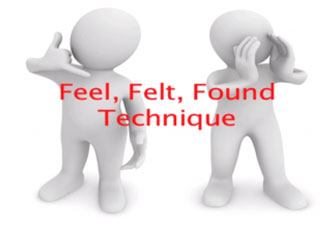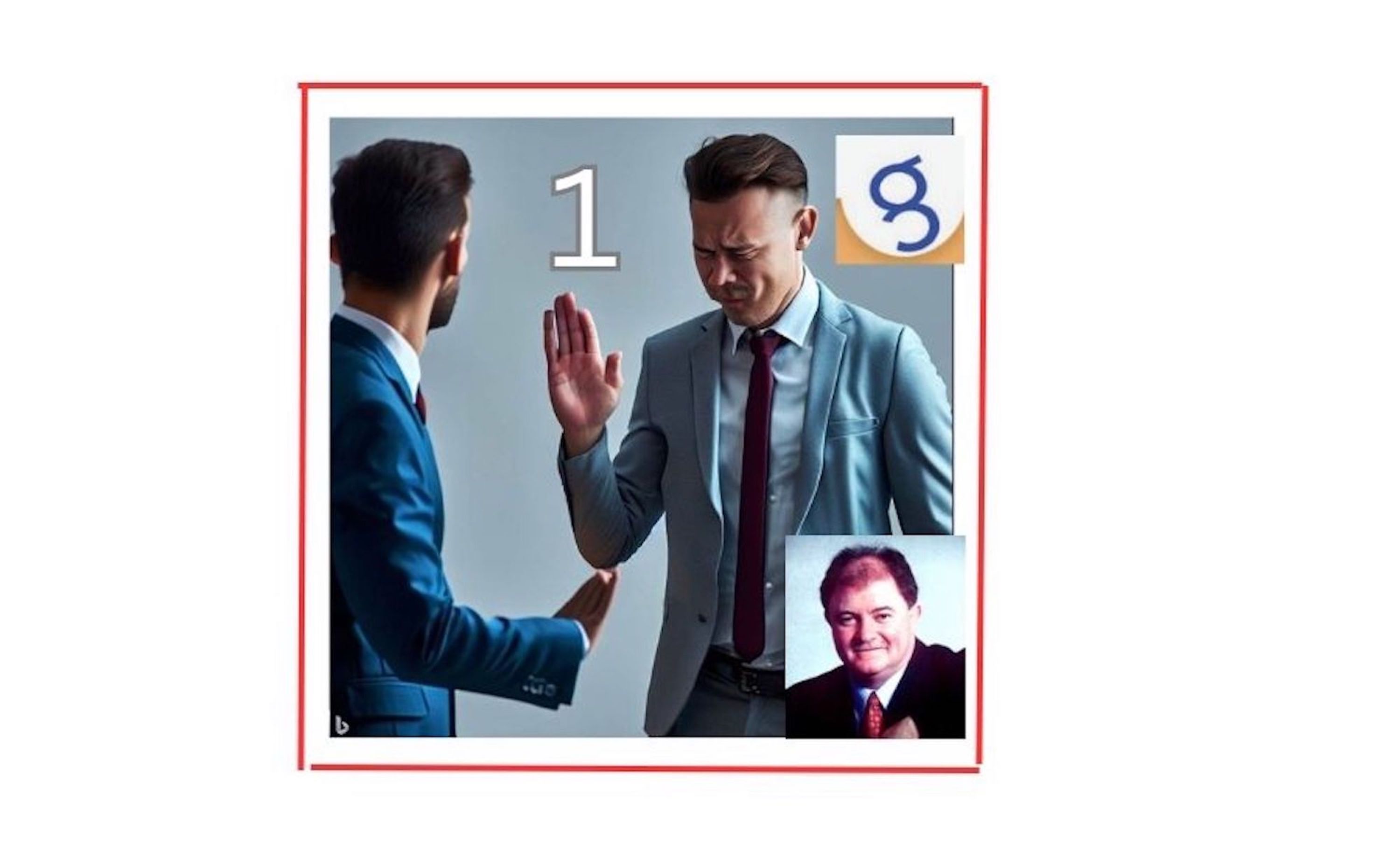Feel Felt Found Technique
- Home
- Sales Objections
- Feel, Felt, Found
What is Feel Felt Found
Feel Felt Found is a simple 3-step technique used to overcome objections in sales conversations. It helps prospects feel understood, builds empathy, and gently reframes their concern.
It works by first showing that you understand how the other person feels (shows empathy and starts to create rapport), then mentioning that others have shared that same reaction (validates their concern and they then start to identify with the "others"), and finally offering a new perspective or solution that helped those people move forward (opens them up to another perspective often via a reframe).
It works because it’s human, respectful, and naturally persuasive.
This technique would be well known to you as an objection-handling formula if you that have been involved sales for any length of time.
It is a technique that has been used for a long time. This familiarity, to both salespeople and buyers, gives rise to advantages and disadvantages.
|
Of course, "feel, felt, found" is just one method of handling sales objections. And, relying on one method is like investing all your hard earned money in one stock. All the smart investors diversify. To find a portfolio of methods to deal with objections. |
|
If you are questions why we get objections. You can read ...
The psychology behind objections.
Examples of Feel, Felt, Found in Action
Just for a review of the method let me take you through an example.
Your prospect says something like,
"I'd love to use your service but we just can't afford it."
(Sound familiar?)
A brief example of using "feel felt found", would be something like the following.
"I understand how you feel.
Mr Jones over at Allied Inc felt the same way for a long time.
Then after he started using our service he found that the added cost was minimal and was far outweighed by the benefits of our premium service."
"I'm not sure it will work for me."
"That’s a common concern, and I get how you feel.
Others in your situation have felt unsure too, but many found it easier than they expected once they started."
This is quite an effective tack for dealing with sales objections.
|
For any method used to overcome objections you still need to have the right attitude for it to work |
Why Does Feel Felt Found Work
So, the question becomes, why does "feel felt found" work and can we use something similar to get the same, or better, results?
I believe it works in handling sales objections for several reasons:
In understanding how they feel you build empathy and rapport with them rather than confronting their belief.
And , the Emotional validation of this move reduces their resistance.
(As I’ve written before, meet them where they are and lead them to where you want them to be)
You are letting them know that this initial thought is common and this puts them at ease as it lets them know they are part of a group (Social Proof).
When they are attached to that group, then you move the whole group by telling how the person in the group bought and changed their mind. (using Social Proof to influence them to buy).
This is a gentle redirection of their thinking rather than arguing or trying to convince.
It's a sort of a bridge from emotion to logic.
By giving details about what others found you also add motivation for them to buy (i.e. don’t just say everything was fine)
In other words it paces the prospect's current experience and then leads them to consider the experience from a different point of view.
(Remember, meet them where they are and lead them to where you want them to be
It Works at a Subconscious Level
Feel Felt Found also works on a more subconscious level
It uses time distortion language
It sells indirectly, via the "quotes" or experience of the other customer.
It tells a story
Everybody Loves to Listen to a Story
Children love it.
People stand around at parties telling them.
People lean over the fence to tell stories to their neighbour.
The minute you start talking about the experience of another person who now uses your product or service you get your prospect involved in the story.
So, you have your prospect's attention.
Master the Art of Objection Handling - Engage with stories, techniques, and strategies that transform objections into opportunities.
Explore other techniques now.
Time Distortion
I love the intricacies of language.
Verb tenses are a particularly good influencing tool.
What this technique does is it moves the prospect's objection into the past and offers an alternative belief for them to consider.
Let me explain.
When you first refer to the prospect's objection using "feel felt found" you use the verb “feel”, which is present tense and thus mirrors the prospect's current thoughts on your offer.
Then when you start talking about “Mr Jones” it is quite likely that your prospect will associate with Mr Jones' experience (especially if they have a similar business) and then you are using "felt" which is past tense.
By using the verb in the past tense you are changing your prospect's objection from an objection they are having now to one that they associate with as being in the past.
This opens up the prospect's future to consider a new reality.
Finally, when you start talking about what Mr Jones "found" you preface that verb with the phrase "after he started using our service".
So, you move the prospect's attention into the future AFTER having used your service and then invite them to consider the good experience that Mr Jones had.
Of course, when they consider what Mr Jones found they are trying it on themselves, aren't they?
Advantages and Disadvantages
So, the advantages of the Feel Felt Found technique are that it’s easy to use and has been used for a long time.
It's usable in a variety of situations:
- Sales calls
- Email responses
- Face-to-face objections
- Coaching,
- Even parenting
The fact that it has been around for a long time creates a problem because it’s been used for a long time and any experienced buyer would recognise it.
And the trouble with any "scripted" approach like this is that it is easy to spot.
There is also the danger that becasue it’s so simple to use that you might overuse the technique and try to answer every objection using it.
There is another concern.
If you are not genuine and don’t really care about the customer their BS detector will pick up on that.
It will break rapport rather than building rapport.
And that will make it a lot harder to handle an objection and close a sale.
|
I have a problem with Scripted Techniques . I favour an approach you can use with ANY objection . I have created a course that gives you a method that is universally applicable for objections. |
 |

Feel Felt Found Made Safer
To make it work optimally, remember all the things you normally do when answering an objection:
- Don't be robotic — deliver naturally
- Always listen fully first
- Don’t fake empathy — mean it
- Practice tone, not just words
Now that you know how “feel felt found" works by using verb tense and story to counter an objection you can come up with a general formula to do something similar, without risking being caught using a “ semi-scripted technique”.
That formula would be something like:
- Agree with the prospect's current objection,
- Move that objection into the past,
- Then take their thoughts into the future and, by implication, invite your prospect to consider having discovered a different reality just like Mr X did.
So, back to our original statement,
"I'd love to use your service but we just can't afford it."
Response
“I appreciate our service is not cheap.
Have you always thought about our service in that way?
Having had that thought it would not have been easy to consider using our product, would it?
You know many of our current clients used to think that same way until they started using our service.
For example, Mr Jones told me, after he'd been using X for a while that his Y far exceeded his previous…"
This achieves the same results as “feel felt found" and is much less likely to be detected as a scripted way of answering sales objections. It is a little more complicated but there is a framework to follow.
Another Option
I ran across a webpage recently that mentions how an NLP trainer, Jonathan Altfeld, uses this technique.
Jonathan replaces “I understand” with “Some people feel…” and this removes the problem of the customer feeling you are insincere. It also further enhances the prospect’s connection to that group.
To quote Jonathan’s example from the webpage …
“I know a lot of people felt that way until they decided to take charge of their future no matter what obstacles present and found that no matter how much random weirdness occurred, it was still up to us to follow through on all our responsibilities and promises.”
For a much more detailed explanation of Jonathan’s approach go read his article "feel-felt-found works better".
Q&A
Is Feel-Felt-Found still effective in 2024?
Yes — and possibly more than ever. In a digital age flooded with pushy sales tactics and AI-generated content, human connection stands out. The Feel-Felt-Found method works because it taps into empathy and relatability — two things that build trust. When used genuinely, it doesn’t feel like a “sales tactic.” It feels like understanding — and that never goes out of style.
What if the objection is aggressive or emotional?
If someone is reacting strongly, it usually means their objection is fueled by emotion — fear, frustration, or past negative experiences. This is exactly when Feel-Felt-Found is most powerful. Start by truly listening (don’t interrupt), then calmly acknowledge how they feel. You might say, “I totally hear how frustrating that can be.” This disarms the situation and lets them know you’re not there to argue — you’re there to help.
Can I use Feel-Felt-Found in writing or email?
Definitely. While it’s often used in verbal conversations, this technique translates well into writing — especially in objection-handling emails, live chat, or even sales pages. The key is tone. Be conversational and empathetic, not robotic. For example:
“I understand how you feel — a few of our customers felt the same way before trying this out. They found it actually saved them time by...”
Just make sure it sounds natural, not templated.
What’s the biggest mistake people make with this technique?
The biggest mistake is sounding fake or formulaic. If you just recite the structure like a script — “I understand how you feel, others felt the same, they found...” — people will see right through it. The power of this method lies in its sincerity. Customize your language to the situation, and genuinely mean what you say. Otherwise, it comes off as manipulative — which is exactly what you’re trying to avoid.
Wrap Up
Using the Feel Felt Found technique or modified process takes some practice but the results could well be worth it.
“Feel Felt Found” is certainly a nice way of overcoming objections.
If you do not want to get caught out you could use the template on this page to devise your own response or try Jonathan’s approach.
Anyway, you don't have to believe me, just give it a try and see what results you get.
Can I use Feel-Felt-Found in writing or email?
Definitely. While it’s often used in verbal conversations, this technique translates well into writing — especially in objection-handling emails, live chat, or even sales pages. The key is tone. Be conversational and empathetic, not robotic. For example:
“I understand how you feel — a few of our customers felt the same way before trying this out. They found it actually saved them time by...”
Just make sure it sounds natural, not templated.
What’s the biggest mistake people make with this technique?
The biggest mistake is sounding fake or formulaic. If you just recite the structure like a script — “I understand how you feel, others felt the same, they found...” — people will see right through it. The power of this method lies in its sincerity. Customize your language to the situation, and genuinely mean what you say. Otherwise, it comes off as manipulative — which is exactly what you’re trying to avoid.
If you want to go beyond theory and master objections in the real world, check out this complete trilogy of video courses on mastering sales objections. It gives you the mindset, tactics, and system to turn objections into closed deals.
No matter what objection you get ...
If you want to get better at handling sales objections you can start
with one of these courses
You might like these
Return to the Sales Objections Menu Page
- Home
- Sales Objections
- Feel, Felt, Found

